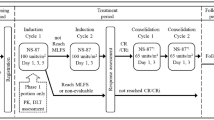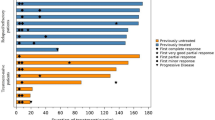Abstract
Purpose
Busulfan-melphalan high-dose chemotherapy followed by autologous stem cell transplantation is an essential consolidation treatment of high-risk neuroblastoma in children. Main treatment limitation is hepatic veno-occlusive disease, the most severe and frequent extra-hematological toxicity. This life threatening toxicity has been related to a drug interaction between busulfan and melphalan which might be increased by prior disturbance of iron homeostasis, i.e. an increased plasma ferritin level.
Methods
We performed an experimental study of busulfan and melphalan pharmacodynamic and pharmacokinetics in iron overloaded mice.
Results
Iron excess dramatically increased the toxicity of melphalan or busulfan melphalan combination in mice but it did not modify the clearance of either busulfan or melphalan. We show that prior busulfan treatment impairs the clearance of melphalan. This clearance alteration was exacerbated in iron overloaded mice demonstrating a pharmacokinetic interaction. Additionally, iron overload increased melphalan toxicity without altering its pharmacokinetics, suggesting a pharmacodynamic interaction between iron and melphalan. Based on iron homeostasis disturbance, we postulated that prior induction of ferritin, through Nrf2 activation after oxidative stress, may be associated with the alteration of melphalan metabolism.
Conclusion
Iron overload increases melphalan and busulfan-melphalan toxicity through a pharmacodynamic interaction and reveals a pharmacokinetic drug interaction between busulfan and melphalan.





Similar content being viewed by others
Abbreviations
- AUC:
-
Area under curve
- BMT:
-
Bone marrow transplantation
- BU:
-
Busulfan
- HSCT:
-
Hematopoietic stem cell transplantation
- HVOD:
-
Hepatic venooclusive disease
- LOD:
-
Limit of detection
- LOQ:
-
Limit of quantification
- MEL:
-
Melphalan
- QC:
-
Quality control
- SFN:
-
Sulforaphane.
- TTP:
-
Thiotepa
References
Meresse V, Hartmann O, Vassal G, Benhamou E, Valteau-Couanet D, Brugieres L, et al. Risk factors for hepatic veno-occlusive disease after high-dose busulfan-containing regimens followed by autologous bone marrow transplantation: a study in 136 children. Bone Marrow Transplant. 1992;10(2):135–41.
Grochow LB, Jones RJ, Brundrett RB, Braine HG, Chen TL, Saral R, et al. Pharmacokinetics of busulfan: correlation with veno-occlusive disease in patients undergoing bone marrow transplantation. Cancer Chemother Pharmacol. 1989;25(1):55–61.
Slattery JT, Kalhorn TF, McDonald GB, Lambert K, Buckner CD, Bensinger WI, et al. Conditioning regimen-dependent disposition of cyclophosphamide and hydroxycyclophosphamide in human marrow transplantation patients. J Clin Oncol. 1996;14(5):1484–94.
Bouligand J, Boland I, Valteau-Couanet D, Deroussent A, Kalifa C, Hartmann O, et al. In children and adolescents, the pharmacodynamics of high-dose busulfan is dependent on the second alkylating agent used in the combined regimen (melphalan or thiotepa). Bone Marrow Transplant. 2003;32(10):979–86.
Ladenstein RL, Poetschger U, Luksch R, Brock P, Castel V, Yaniv I, et al. Busulphan-melphalan as a myeloablative therapy (MAT) for high-risk neuroblastoma: results from the HR-NBL1/SIOPEN trial. ASCO Meeting Abstracts. 2011;29 Suppl 15:2.
Bouligand J, Deroussent A, Simonnard N, Opolon P, Morizet J, Connault E, et al. Induction of glutathione synthesis explains pharmacodynamics of high-dose busulfan in mice and highlights putative mechanisms of drug interaction. Drug Metab Dispos. 2007;35(2):306–14.
Bouligand J, Le Maitre A, Valteau-Couanet D, Grill J, Drouard-Troalen L, Paci A, et al. Elevated plasma ferritin and busulfan pharmacodynamics during high-dose chemotherapy regimens in children with malignant solid tumors. Clin Pharmacol Ther. 2007;82(4):402–9.
Cacchione A, LeMaitre A, Couanet DV, Benhamou E, Amoroso L, Simonnard N, et al. Risk factors for hepatic veno-occlusive disease: a retrospective unicentric study in 116 children autografted after a high-dose BU-thiotepa regimen. Bone Marrow Transplant. 2008;42(7):449–54.
Vassal G, Re M, Gouyette A. Gas chromatographic-mass spectrometric assay for busulfan in biological fluids using a deuterated internal standard. J Chromatogr. 1988;428(2):357–61.
Millar JL, Hudspith BN, McElwain TJ, Phelps TA. Effect of high-dose melphalan on marrow and intestinal epithelium in mice pretreated with cyclophosphamide. Br J Cancer. 1978;38(1):137–42.
Castellino S, Elion GB, Griffith OW, Dewhirst M, Kurtzberg J, Cattley RC, et al. Development of a model of melphalan-induced gastrointestinal toxicity in mice. Cancer Chemother Pharmacol. 1993;31(5):376–80.
Bouligand J, Delemer B, Hecart AC, Meduri G, Viengchareun S, Amazit L, et al. Familial glucocorticoid receptor haploinsufficiency by non-sense mediated mRNA decay, adrenal hyperplasia and apparent mineralocorticoid excess. PLoS ONE. 2010;5(10):e13563.
Maione L, Albarel F, Bouchard P, Gallant M, Flanagan CA, Bobe R, et al. R31C GNRH1 mutation and congenital hypogonadotropic hypogonadism. PLoS ONE. 2013;8(7):e69616.
Vassal G, Deroussent A, Challine D, Hartmann O, Koscielny S, Valteau-Couanet D, et al. Is 600 mg/m2 the appropriate dosage of busulfan in children undergoing bone marrow transplantation? Blood. 1992;79(9):2475–9.
Srivastava A, Poonkuzhali B, Shaji RV, George B, Mathews V, Chandy M, et al. Glutathione S-transferase M1 polymorphism: a risk factor for hepatic venoocclusive disease in bone marrow transplantation. Blood. 2004;104(5):1574–7.
Kallianpur AR, Hall LD, Yadav M, Byrne DW, Speroff T, Dittus RS, et al. The hemochromatosis C282Y allele: a risk factor for hepatic veno-occlusive disease after hematopoietic stem cell transplantation. Bone Marrow Transplant. 2005;35(12):1155–64.
Gordon LI, Brown SG, Tallman MS, Rademaker AW, Weitzman SA, Lazarus HM, et al. Sequential changes in serum iron and ferritin in patients undergoing high-dose chemotherapy and radiation with autologous bone marrow transplantation: possible implications for treatment related toxicity. Free Radic Biol Med. 1995;18(3):383–9.
Evens AM, Mehta J, Gordon LI. Rust and corrosion in hematopoietic stem cell transplantation: the problem of iron and oxidative stress. Bone Marrow Transplant. 2004;34(7):561–71.
Thimmulappa RK, Mai KH, Srisuma S, Kensler TW, Yamamoto M, Biswal S. Identification of Nrf2-regulated genes induced by the chemopreventive agent sulforaphane by oligonucleotide microarray. Cancer Res. 2002;62(18):5196–203.
Marzec JM, Christie JD, Reddy SP, Jedlicka AE, Vuong H, Lanken PN, et al. Functional polymorphisms in the transcription factor NRF2 in humans increase the risk of acute lung injury. FASEB J. 2007;21(9):2237–46.
Bouligand J, Cabaret O, Canonico M, Verstuyft C, Dubert L, Becquemont L, et al. Effect of NFE2L2 genetic polymorphism on the association between oral estrogen therapy and the risk of venous thromboembolism in postmenopausal women. Clin Pharmacol Ther. 2011;89(1):60–4.
Vassal G, Michel G, Esperou H, Gentet JC, Valteau-Couanet D, Doz F, et al. Prospective validation of a novel IV busulfan fixed dosing for paediatric patients to improve therapeutic AUC targeting without drug monitoring. Cancer Chemother Pharmacol. 2008;61(1):113–23.
Nguyen L, Paci A, Vassal G. Population pharmacokinetics of busulfan in children--letter. Clin Cancer Res. 2011;18(9):2715–6. author reply 2717–2718.
Paci A, Vassal G, Moshous D, Dalle JH, Bleyzac N, Neven B, et al. Pharmacokinetic behavior and appraisal of intravenous busulfan dosing in infants and older children: the results of a population pharmacokinetic study from a large pediatric cohort undergoing hematopoietic stem-cell transplantation. Ther Drug Monit. 2012;34(2):198–208.
Coles BF, Morel F, Rauch C, Huber WW, Yang M, Teitel CH, et al. Effect of polymorphism in the human glutathione S-transferase A1 promoter on hepatic GSTA1 and GSTA2 expression. Pharmacogenetics. 2001;11(8):663–9.
Hartikainen JM, Tengstrom M, Kosma VM, Kinnula VL, Mannermaa A, Soini Y. Genetic polymorphisms and protein expression of NRF2 and Sulfiredoxin predict survival outcomes in breast cancer. Cancer Res. 2012;72(21):5537–46.
ACKNOWLEDGMENTS AND DISCLOSURES
We thank all the staff of the animal unit at the Institute Gustave Roussy for their care of the animals. We are grateful to Irina Radu-Bouligand for editing the manuscript.
Author information
Authors and Affiliations
Corresponding author
Rights and permissions
About this article
Cite this article
Bouligand, J., Richard, C., Valteau-Couanet, D. et al. Iron Overload Exacerbates Busulfan-Melphalan Toxicity Through a Pharmacodynamic Interaction in Mice. Pharm Res 33, 1913–1922 (2016). https://doi.org/10.1007/s11095-016-1927-z
Received:
Accepted:
Published:
Issue Date:
DOI: https://doi.org/10.1007/s11095-016-1927-z




